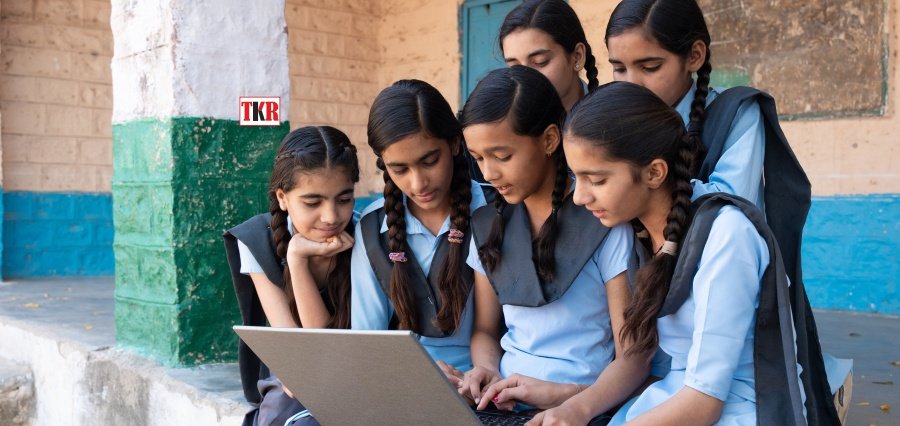An academic, economic, and social perspective
It was 5.45 p.m., August 23, 2023, when the “rough braking” phase started and Chandrayaan-3 was seen in its orbit, 30 km above the moon, while its horizontal distance from the launch site was 750 km. Afterwards, a 10-second “attitude hold phase” began. During this time, the lander was settling down by using its four legs and four thrusters to observe the lunar surface for a safe touchdown. The third phase was called “fine braking”, where the spacecraft descended up to 850 meters above the surface of the moon and started hovering. Hovering aimed to look for a suitable “parking spot”. In the last phase, “terminal descent”, Chnadrayaan-3 came down approximately 150 meters above the lunar surface. At this point, it again started hovering for around 30 seconds to measure all the parameters for a safe landing. It was reported that the lander disfavoured the area right below, which led it to drift safely to an adjacent area. Upon touching the surface of the moon, the sensors attached to the four legs of the lander module initiated the shutdown process of the main engine. When this write-up is typed, Chandrayaan-3 is gloriously standing on the moon’s south pole. This establishes the first human contact with the south pole of the moon.
For landing purposes, any polar region of a celestial body is more challenging than the equator region. Due to this reason, the south pole of the moon was unexplored for a significant period. As per the reporting in Time, it was predicted by scientists that the soil of the moon is somewhat like crystals of water ice, while the “shadowed craters” could be frozen lakes. Time reporting also mentioned that, in 2008, Chandrayaan-1 proved all these speculations correct. We all understand the meaning of the presence of water molecules on the moon. It doesn’t only imply the possibility of getting drinking water but also the extraction of breathable oxygen. The hydrogen in water ice can be a potential candidate for making rocket fuel. “Ancient water ice” can also help us to understand the geology of the moon. Due to these promising features, the south pole of the moon has become the bull’s eye for many countries. India created history when it became the first country in the world to successfully land on the moon’s south pole.
As an Indian, this touchdown triggered in me a recollection, such as that astronomical studies in India started around 600 C.E. with Aryabhata and Varahamihir. Aryabhata proposed that sunlight gets reflected by the moon and that the earth is a rotating object, not the sky.
Subsequently, Varahamihir introduced the profound concept that, due to an attractive force, all celestial objects are bound in their locations. This shows that they were quite ahead of their time. Since then, to the present, when India probed the most desirable region of the moon, it can be inferred that, with respect to us, we have acquired more knowledge, we have become more enriched, we have become more skilled, we have grown more than our ancestors, we have advanced their legacy, we have constructed our own path, and we have created history. I recognise this as our achievement.
Educational Impact:
It’s beyond doubt that one of the key factors behind the success of mission Chandrayaan-3 is a rich amalgamation of expertise and skills from diverse educational backgrounds. Citing examples, Kalpana K, Associate Project Director, Chandrayaan-3, graduated with a degree in Aeronautical Engineering while Ritu Karidhal Srivastava, a Senior Scientist, Chandrayaan-3, graduated in Physics. Similarly, ISRO’s Chairperson S Somnath has earned his bachelor’s degree in mechanical engineering while M Sankaran, the head of the U R Rao Satellite Centre, has accomplished a master’s degree in physics and joined ISRO Satellite Centre (URSC). These diversified profiles of leaders convey an important message that appropriate collaboration may lead us to design and fulfil such a magnificent endeavour.
I believe looking up to the night sky may induce enough motivation to be curious about space. However, in the context of our country, consistent success stories of ISRO can create an additional thrust for our students to be more than just curious. In the present scenario, I expect that the branches like Astrophysics, Astronomy, Cosmology, Aeronautical Engineering, Space Science etc., may gain more attention from the students in order to pursue specialised higher studies. It’s worth mentioning here that the Laser Interferometer Gravitational Wave Observatory (LIGO), India project has also been planned and the MoU is signed by the Department of Atomic Energy (DAE) and the US National Science Foundation (NSF). The purpose of this observatory is different than ISRO and will explore a different angle of Gravitational Physics, which is primarily based on Einstein’s theory of General Relativity. From the successful construction and running of LIGO-India, multifaceted benefits may emerge in the field of Astrophysical research in India.
In regard to all these investments in observational science, I want to add a note of caution that we must not neglect the theoretical research/studies as, largely, the purpose of these observations is to validate/invalidate the existing theoretical models. It’s well known that in 2015, the discovery of the Gravitational Waves in LIGO validated one of the outcomes of Einstein’s General Relativity. Can you imagine that it almost took 100 years for observational science to catch up with the pace of Einstein’s mind? It suggests, that if not invalidated by the observations, scientific theories are quite alive. Thus, we need a proper balance of economic and structural investments in both observational and theoretical research.
Economic Impacts:
This section cannot be covered only with respect to the success of Chandrayaan 3. Rather, being motivated by the consistent success of ISRO’s missions, space-oriented activities such as research or commercial pursuits have been turned into one of the controlling players in our economy. ISRO was a principal organization that had permission to probe space by launching satellites, payloads, spacecraft, etc. Since 2020, when the Government of India announced that private companies would be given the authorization to explore the space sector, people have observed a spectacular change in space-based industries. This authorization earned loads of attention from private companies which were almost ready to deliver for space-based missions. Although some of the startups were initiated before the year 2020, the formal approval from the government provided a thrust to these startups in order to pursue their respective ventures. Some of the well-known names along this line are Sky root Aerospace, SatSure, Pixxel, Newspace Research & Technologies, Dhruva Space, Digantara, Bellatrix Aerospace etc. For example, a startup like Pixxel was founded by two Bits Pilani alumni, Awais Ahmed and Kshitij Khandelwal in 2019. Pixel focuses on constructing a constellation of hyperspectral earth imaging satellites and also developing analytical aids to interpret the collected data from the satellites. Google declared $36 million of investment in Pixxel, which can be considered a huge investment after the space privatisation policy. Another example is the Skyroot aerospace startup, which turned out to be the first private company in India to launch a rocket, named Vikram-S, into space in 2022 from the Satish Dhawan Space Centre, Sriharikota. In the same year, it was disclosed that ISRO has signed MoUs with private companies to work in collaboration, aiming to explore the new age space technologies and “building processes from start to finish”. Further, it was also mentioned that approximately 100 startups have been registered with ISRO.
An article published in India Today (digital), dated July 8, 2023, shows that these space-based startups are trying to address some real life issues such as, “satellite-based phone signals, broadband, OTT, and 5G to the operations of solar farms, etc.” The same source captures comments by P Chandana, founder of Skyroot, which reflects that the success of Chandrayaan-3 and the involvement of the private sector will produce more businesses, employment and more startups.
At this stage, I want to represent the team of whistle blowers and leave the readers with some spontaneous questions: It was published in The Guardian, on January 5, 2023, that light pollution is heavily interrupting astronomical observations as more than 3,000 of the 5,000 active satellites are orbiting the earth. These satellites belong to Elon Musk’s company SpaceX. Similarly, due to the massive involvement of private companies in India, the number of satellites will increase by leaps and bounds. In the rat race of “world satellite dominance”, what will happen to space pollution? What about the space debris limit, which are the human-created items in space? Do we know the economic impact of these missions on a local level? Do we have balanced economic planning so that a part of this economic growth will be diffused through all the people of our country? I hope, in parallel to exploration, we will also look for possible solutions to such queries.
Social Impacts:
ISRO’s success in the Chandrayaan-3 mission has created an enormous impact on some parts of our society. In our country, we have witnessed that people are gradually developing some curiosity about space missions and closely following their progress. As a matter of fact, on August 23, in one instant of time, approximately 7 million people were watching the live streaming of the landing of Chandrayaan-3 on ISRO’s YouTube page. This engagement was mutual as we have seen that throughout the travelling period of Chandrayaan-3, the social media handle of ISRO was consistently updating regarding the whereabouts of the lander module. In recent times, Mission Chnadrayaan-1 to 3 and Mission Mangalyaan, have triggered inquisitiveness among the common people of our country. They have started taking an interest in knowing what will happen next. What are the upcoming ventures of ISRO? What are the outcomes of these projects? etc. Undoubtedly, this is a positive change for our society.
Then, what about the part of our country where people have no access to information such as television, smartphones, mobile networks, or perhaps even electricity? What about the people who are indifferent to these achievements as they are occupied with tolerating their hunger or preparing to sleep under the open sky? These questions are easy, and answers are also known. So, I leave it up to the readers to think and comprehend. I hope in future we will celebrate such achievements all together, but not in parts.
About the Author
Dr Ashmita Das is an Assistant Professor at the Department of Physics, SRM University, AP
Read More: Click Here





